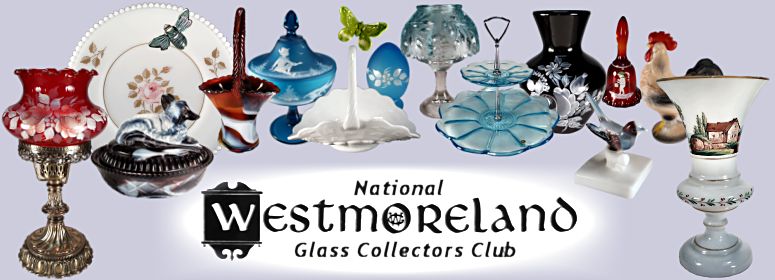Frequently Asked Questions
No, we suggest you consult one of the books listed in our Library reference section or see similar items listed on eBay.com for current market values.
We will try our best. We would be happy to provide you with information and try to identify your glass. Please send us a clear photo of the glass to the webmaster at westmorelandglass@gmail.com.
Of course yo should join ! We would love to have you as a member even if you only own a few pieces of Westmoreland. Our newsletter offers information on Westmoreland glass and you can advertise your glass for sale or buy from other members selling their glass. Our yearly convention provides more opportunity to add and learn more about your collection, and you will definitely make new friends!
Tough question. Gaining knowledge of Westmoreland's production colors and markings is the best way to learn whether your piece is a reproduction. There is a difference between a reissue and a reproduction. Westmoreland often would pull out an old mould from days gone by and start producing again. This would be a reissue. Plum, Rosso, Fenton, Mosser, Summitt, A.A. Importing and other glass companies purchased Westmoreland moulds and started producing from them. These would be reproductions. Most often the Westmoreland mark has been removed but not in all cases. For example, Plum Glass Company of Plum, Pennsylvania was founded by former Westmoreland workers and never removed the Westmoreland marks from the moulds. On the other hand, Rosso Glass always removes the Westmoreland mark. Generally you can tell if it is a reproduction by the color or decoration. You can always post a picture of piece in the various glass forum sites on the Internet and Facebook or you may contact the Webmaster at westmorelandglass@gmail.com if you have a question.
No. The placing of a company's trademark on glass by the manufacturing glass company did not come into common use until the mid-1900s. In the early stages of Westmoreland from 1889 through about 1910 glass was not typically marked. However, Westmoreland did use paper labels as early as 1906 that say "Westmoreland Specialty Company." These rectangular or round paper labels can be found on mustard containers and other wares including a 1906 Shriner's plate. In the 1910s Westmoreland started to mark their glass with a "W" found inside of a keystone, commonly referred to by collectors as the "Keystone W" mark. This particular mark was used up through the 1940s but was not placed on all glass produced by Westmoreland. The "WG" mark was developed in 1946. The "WG" mark is a "W" intertwined with a "G." This mark was placed primarily on the bottom of the ware. Also, Westmoreland developed small round stickers to be placed on the glass that identified the company. One should be aware that as the mould was repeatedely used it was common that the mark would evenually fade so you can find some items during this era with a faded mark or appears to be unmarked. When the company was sold to David Grossman in 1981, Grossman came up with his own mark that was placed on the ware. The Grossman mark can be found on a number of reproduced items because glass companies that bought moulds at the factory's closing but did not always replace or delete the mark.
The most common misconception or misnomer among dealers and collectors in the past about Westmoreland Glass is that it was a "milk glass" company and not much more. Westmoreland did produce a superior milk glass product throughout its history, especially during the Brainard years from 1937 to 1980. But Westmoreland was much more than a milk glass company. Westmoreland had wonderful decorators and engravers that hand-painted and cut glass. Westmoreland actively recruited decorators from Italy and Bohemia whom migrated to the United States and worked for Westmoreland. The high point for Westmoreland for hand-work decoration was the 1920s when former co-founder and President of Westmoreland, George R. West, bragged to a trade magazine that Westmoreland had the largest decorating department in the country. Westmoreland had in its factory the genius of master engraver, Joseph Racinger, and the designer Ruben Haley, both of whom eventually left Westmoreland and established their own personal identities and following in the glass world. Louise Piper began her career hand-painting glass at Westmoreland and eventually had a wonderful career at the Fenton Glass Company. Head Decorator Ernie Brown learned from the former head decorator Fred Otte who in turned learned from former Head Decorator Frank Yager. Ernie went on to create collectible decorations including Roses and Bows, Ruby Floral, and Beaded Boquet to name a few. Other noted decorators include Don Green, Cindy Peltier, Chuck Steeley, and Noreen Laughner, just to name a few.
You can contact the webmaster at westmorelandglass@gmail.com if you wish to sell all or part of your family's glass collection. The webmaster can provide information to you on how you maybe able to best sell your collection.

